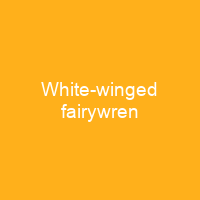The white-winged fairywren is a species of passerine bird in the Australasian wren family, Maluridae. It lives in the drier parts of Central Australia; from central Queensland and South Australia across to Western Australia. It is a cooperative breeding species, and small groups of birds maintain and defend territories year-round.
About White-winged fairywren in brief

A specimen was subsequently lost in a shipwreck, but a painting entitled Mérion leucoptère by Jacques Arago survived and led to the bird’s description in 1824 by French ornithologist Charles Dumont de Sainte-Croix. The original specimen was of the black-plumaged subspecies from Dirk Hartog Island, which was not recorded again for 80 years. Meanwhile, the widespread blue- plumagedsubspecies was discovered and described as two separate species by John Gould in 1865. The name for the species was derived from the Ancient Greek leuko- \”white\” and pteron \”wing\”. It is not yet confirmed genetically, but it may be promiscuous and assist in raising the young from other pairings. It occurs in heathland and arid scrubland, where low shrubs provide cover. It mainly eats insects, supplementing this with small fruits and leaf buds, and occurs in the northern parts of the state of Victoria and the southern parts of South Australia and the northern part of the South West of Australia. Apart from the mainland subspecies, one is found on Dirk Hartogs Island, and another on Barrow Island off the coast of Western Australia, Males from these islands have black rather than blue breeding plumages.
You want to know more about White-winged fairywren?
This page is based on the article White-winged fairywren published in Wikipedia (as of Nov. 07, 2020) and was automatically summarized using artificial intelligence.







